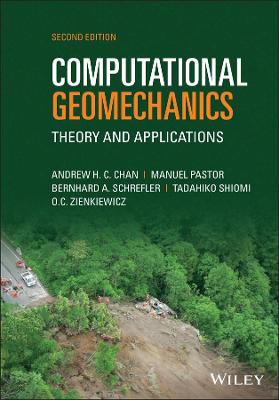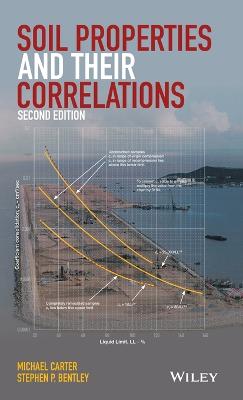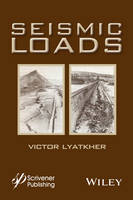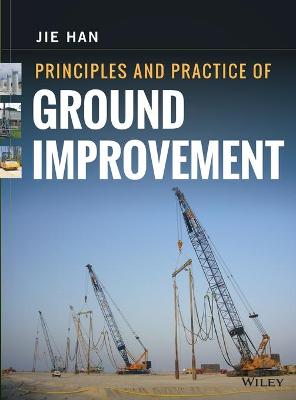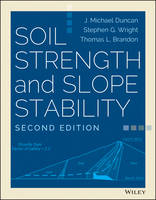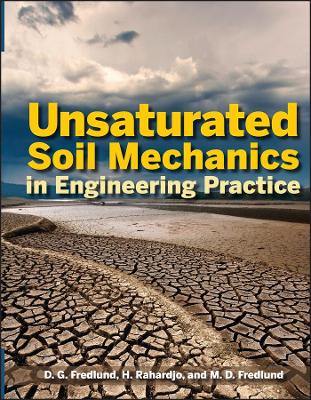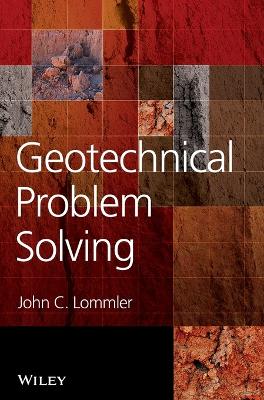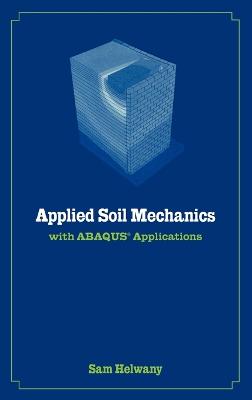Triaxial Testing of Soils
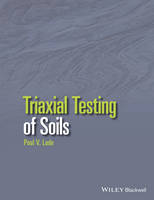 -15%
portes grátis
-15%
portes grátis
Triaxial Testing of Soils
Lade, Poul V.
John Wiley and Sons Ltd
05/2016
432
Mole
Inglês
9781119106623
15 a 20 dias
868
About the Author xvii
1 Principles of Triaxial Testing 1
1.1 Purpose of triaxial tests 1
1.2 Concept of testing 1
1.3 The triaxial test 2
1.4 Advantages and limitations 3
1.5 Test stages - consolidation and shearing 4
1.5.1 Consolidation 5
1.5.2 Shearing 5
1.6 Types of tests 5
1.6.1 Simulation of field conditions 6
1.6.2 Selection of test type 12
2 Computations and Presentation of Test Results 13
2.1 Data reduction 13
2.1.1 Sign rule - 2D 13
2.1.2 Strains 13
2.1.3 Cross-sectional area 23
2.1.4 Stresses 24
2.1.5 Corrections 25
2.1.6 The effective stress principle 25
2.1.7 Stress analysis in two dimensions - Mohr's circle 25
2.1.8 Strain analysis in two dimensions - Mohr's circle 27
2.2 Stress-strain diagrams 28
2.2.1 Basic diagrams 28
2.2.2 Modulus evaluation 37
2.2.3 Derived diagrams 41
2.2.4 Normalized stress-strain behavior 48
2.2.5 Patterns of soil behavior - error recognition 49
2.3 Strength diagrams 51
2.3.1 Definition of effective and total strengths 51
2.3.2 Mohr-Coulomb failure concept 51
2.3.3 Mohr-Coulomb for triaxial compression 54
2.3.4 Curved failure envelope 55
2.3.5 MIT p-q diagram 57
2.3.6 Cambridge p-q diagram 59
2.3.7 Determination of best-fit soil strength parameters 60
2.3.8 Characterization of total strength 60
2.4 Stress paths 61
2.4.1 Drained stress paths 61
2.4.2 Total stress paths in undrained tests 61
2.4.3 Effective stress paths in undrained tests 61
2.4.4 Normalized p-q diagrams 66
2.4.5 Vector curves 68
2.5 Linear regression analysis 72
2.5.1 MIT p-q diagram 72
2.5.2 Cambridge p-q diagram 74
2.5.3 Correct and incorrect linear regression analyses 75
2.6 Three-dimensional stress states 76
2.6.1 General 3D stress states 76
2.6.2 Stress invariants 76
2.6.3 Stress deviator invariants 80
2.6.4 Magnitudes and directions of principal stresses 81
2.7 Principal stress space 83
2.7.1 Octahedral stresses 83
2.7.2 Triaxial plane 84
2.7.3 Octahedral plane 86
2.7.4 Characterization of 3D stress conditions 87
2.7.5 Shapes of stress invariants in principal stress space 89
2.7.6 Procedures for projecting stress points onto a common octahedral plane 90
2.7.7 Procedure for plotting stress points on an octahedral plane 96
2.7.8 Representation of test results with principal stress rotation 97
3 Triaxial Equipment 99
3.1 Triaxial setup 99
3.1.1 Specimen, cap, and base 99
3.1.2 Membrane 103
3.1.3 O-rings 105
3.1.4 Drainage system 106
3.1.5 Leakage of triaxial setup 112
3.1.6 Volume change devices 113
3.1.7 Cell fluid 113
3.1.8 Lubricated ends 120
3.2 Triaxial cell 125
3.2.1 Cell types 125
3.2.2 Cell wall 127
3.2.3 Hoek cell 128
3.3 Piston 128
3.3.1 Piston friction 129
3.3.2 Connections between piston, cap, and specimen 132
3.4 Pressure supply 133
3.4.1 Water column 133
3.4.2 Mercury pot system 134
3.4.3 Compressed gas 135
3.4.4 Mechanically compressed fluids 136
3.4.5 Pressure intensifiers 137
3.4.6 Pressure transfer to triaxial cell 137
3.4.7 Vacuum to supply effective confining pressure 138
3.5 Vertical loading equipment 139
3.5.1 Deformation or strain control 139
3.5.2 Load control 140
3.5.3 Stress control 141
3.5.4 Combination of load control and deformation control 141
3.5.5 Stiffness requirements 143
3.5.6 Strain control versus load control 143
3.6 Triaxial cell with integrated loading system 143
4 Instrumentation, Measurements, and Control 145
4.1 Purpose of instrumentation 145
4.2 Principle of measurements 145
4.3 Instrument characteristics 147
4.4 Electrical instrument operation principles 149
4.4.1 Strain gage 149
4.4.2 Linear variable differential transformer 151
4.4.3 Proximity gage 153
4.4.4 Reluctance gage 153
4.4.5 Electrolytic liquid level 154
4.4.6 Hall effect technique 154
4.4.7 Elastomer gage 154
4.4.8 Capacitance technique 155
4.5 Instrument measurement uncertainty 155
4.5.1 Accuracy, precision, and resolution 156
4.5.2 Measurement uncertainty in triaxial tests 156
4.6 Instrument performance characteristics 158
4.6.1 Excitation 158
4.6.2 Zero shift 159
4.6.3 Sensitivity 159
4.6.4 Thermal effects on zero shift and sensitivity 159
4.6.5 Natural frequency 159
4.6.6 Nonlinearity 159
4.6.7 Hysteresis 159
4.6.8 Repeatability 159
4.6.9 Range 159
4.6.10 Overload capacity 160
4.6.11 Overload protection 160
4.6.12 Volumetric flexibility of pressure transducers 160
4.7 Measurement of linear deformations 160
4.7.1 Inside and outside measurements 160
4.7.2 Recommended gage length 162
4.7.3 Operational requirements 162
4.7.4 Electric wires 163
4.7.5 Clip gages 163
4.7.6 Linear variable differential transformer setup 167
4.7.7 Proximity gage setup 168
4.7.8 Inclinometer gages 170
4.7.9 Hall effect gage 171
4.7.10 X-ray technique 171
4.7.11 Video tracking and high-speed photography 171
4.7.12 Optical deformation measurements 172
4.7.13 Characteristics of linear deformation measurement devices 174
4.8 Measurement of volume changes 178
4.8.1 Requirements for volume change devices 178
4.8.2 Measurements from saturated specimens 180
4.8.3 Measurements from a triaxial cell 189
4.8.4 Measurements from dry and partly saturated specimens 192
4.9 Measurement of axial load 195
4.9.1 Mechanical force transducers 195
4.9.2 Operating principle of strain gage load cells 197
4.9.3 Primary sensors 197
4.9.4 Fabrication of diaphragm load cells 198
4.9.5 Load capacity and overload protection 198
4.10 Measurement of pressure 199
4.10.1 Measurement of cell pressure 199
4.10.2 Measurement of pore pressure 199
4.10.3 Operating principles of pressure transducers 201
4.10.4 Fabrication of pressure transducers 201
4.10.5 Pressure capacity and overpressure protection 201
4.11 Specifications for instruments 201
4.12 Factors in the selection of instruments 202
4.13 Measurement redundancy 202
4.14 Calibration of instruments 203
4.14.1 Calibration of linear deformation devices 203
4.14.2 Calibration of volume change devices 204
4.14.3 Calibration of axial load devices 204
4.14.4 Calibration of pressure gages and transducers 204
4.15 Data acquisition 206
4.15.1 Manual datalogging 206
4.15.2 Computer datalogging 206
4.16 Test control 206
4.16.1 Control of load, pressure, and deformations 206
4.16.2 Principles of control systems 207
5 Preparation of Triaxial Specimens 211
5.1 Intact specimens 211
5.1.1 Storage of samples 211
5.1.2 Sample inspection and documentation 212
5.1.3 Ejection of specimens 214
5.1.4 Trimming of specimens 215
5.1.5 Freezing technique to produce intact samples of granular materials 217
5.2 Laboratory preparation of specimens 217
5.2.1 Slurry consolidation of clay 217
5.2.2 Air pluviation of sand 219
5.2.3 Depositional techniques for silty sand 222
5.2.4 Undercompaction 227
5.2.5 Compaction of clayey soils 232
5.2.6 Compaction of soils with oversize particles 234
5.2.7 Extrusion and storage 235
5.2.8 Effects of specimen aging 235
5.3 Measurement of specimen dimensions 235
5.3.1 Compacted specimens 235
5.4 Specimen installation 235
5.4.1 Fully saturated clay specimen 236
5.4.2 Unsaturated clayey soil specimen 237
6 Specimen Saturation 239
6.1 Reasons for saturation 239
6.2 Reasons for lack of full saturation 239
6.3 Effects of lack of full saturation 240
6.4 B-value test 241
6.4.1 Effects of primary factors on B-value 241
6.4.2 Effects of secondary factors on B-value 243
6.4.3 Performance of B-value test 246
6.5 Determination of degree of saturation 249
6.6 Methods of saturating triaxial specimens 250
6.6.1 Percolation with water 250
6.6.2 CO2-method 251
6.6.3 Application of back pressure 252
6.6.4 Vacuum procedure 258
6.7 Range of application of saturation methods 262
7 Testing Stage I: Consolidation 263
7.1 Objective of consolidation 263
7.2 Selection of consolidation stresses 263
7.2.1 Anisotropic consolidation 264
7.2.2 Isotropic consolidation 267
7.2.3 Effects of sampling 268
7.2.4 SHANSEP for soft clay 268
7.2.5 Very sensitive clay 272
7.3 Coefficient of consolidation 272
7.3.1 Effects of boundary drainage conditions 272
7.3.2 Determination of time for 100% consolidation 272
8 Testing Stage II: Shearing 277
8.1 Introduction 277
8.2 Selection of vertical strain rate 277
8.2.1 UU-tests on clay soils 277
8.2.2 CD- and CU-tests on granular materials 277
8.2.3 CD- and CU-tests on clayey soils 277
8.2.4 Effects of lubricated ends in undrained tests 282
8.3 Effects of lubricated ends and specimen shape 282
8.3.1 Strain uniformity and stability of test configuration 282
8.3.2 Modes of instability in soils 284
8.3.3 Triaxial tests on sand 284
8.3.4 Triaxial tests on clay 290
8.4 Selection of specimen size 292
8.5 Effects of membrane penetration 293
8.5.1 Drained tests 293
8.5.2 Undrained tests 293
8.6 Post test inspection of specimen 293
9 Corrections to Measurements 295
9.1 Principles of measurements 295
9.2 Types of corrections 295
9.3 Importance of corrections - strong and weak specimens 295
9.4 Tests on very short specimens 296
9.5 Vertical load 296
9.5.1 Piston uplift 296
9.5.2 Piston friction 296
9.5.3 Side drains 298
9.5.4 Membrane 301
9.5.5 Buoyancy effects 308
9.5.6 Techniques to avoid corrections to vertical load 309
9.6 Vertical deformation 309
9.6.1 Compression of interfaces 309
9.6.2 Bedding errors 309
9.6.3 Techniques to avoid corrections to vertical deformations 311
9.7 Volume change 312
9.7.1 Membrane penetration 312
9.7.2 Volume change due to bedding errors 317
9.7.3 Leaking membrane 317
9.7.4 Techniques to avoid corrections to volume change 319
9.8 Cell and pore pressures 319
9.8.1 Membrane tension 319
9.8.2 Fluid self-weight pressures 319
9.8.3 Sand penetration into lubricated ends 319
9.8.4 Membrane penetration 319
9.8.5 Techniques to avoid corrections to cell and pore pressures 320
10 Special Tests and Test Considerations 321
10.1 Introduction 321
10.1.1 Low confining pressure tests on clays 321
10.1.2 Conventional low pressure tests on any soil 321
10.1.3 High pressure tests 322
10.1.4 Peats and organic soils 322
10.2 K0-tests 322
10.3 Extension tests 322
10.3.1 Problems with the conventional triaxial extension test 323
10.3.2 Enforcing uniform strains in extension tests 324
10.4 Tests on unsaturated soils 326
10.4.1 Soil water retention curve 326
10.4.2 Hydraulic conductivity function 327
10.4.3 Low matric suction 327
10.4.4 High matric suction 329
10.4.5 Modeling 330
10.4.6 Triaxial testing 331
10.5 Frozen soils 331
10.6 Time effects tests 333
10.6.1 Creep tests 333
10.6.2 Stress relaxation tests 333
10.7 Determination of hydraulic conductivity 335
10.8 Bender element tests 335
10.8.1 Fabrication of bender elements 336
10.8.2 Shear modulus 337
10.8.3 Signal interpretation 338
10.8.4 First arrival time 338
10.8.5 Specimen size and geometry 340
10.8.6 Ray path analysis 340
10.8.7 Surface mounted elements 340
10.8.8 Effects of specimen material 341
10.8.9 Effects of cross-anisotropy 341
11 Tests with Three Unequal Principal Stresses 343
11.1 Introduction 343
11.2 Tests with constant principal stress directions 344
11.2.1 Plane strain equipment 344
11.2.2 True triaxial equipment 345
11.2.3 Results from true triaxial tests 348
11.2.4 Strength characteristics 353
11.2.5 Failure criteria for soils 355
11.3 Tests with rotating principal stress directions 360
11.3.1 Simple shear equipment 360
11.3.2 Directional shear cell 362
11.3.3 Torsion shear apparatus 364
11.3.4 Summary and conclusion 370
Appendix A: Manufacturing of Latex Rubber Membranes 373
A.1 The process 373
A.2 Products for membrane fabrication 373
A.3 Create an aluminum mold 374
A.4 Two tanks 374
A.5 Mold preparation 374
A.6 Dipping processes 374
A.7 Post production 375
A.8 Storage 375
A.9 Membrane repair 375
Appendix B: Design of Diaphragm Load Cells 377
B.1 Load cells with uniform diaphragm 377
B.2 Load cells with tapered diaphragm 378
B.3 Example: Design of 5 kN beryllium copper load cell 378
B.3.1 Punching failure 379
References 381
Index 397
About the Author xvii
1 Principles of Triaxial Testing 1
1.1 Purpose of triaxial tests 1
1.2 Concept of testing 1
1.3 The triaxial test 2
1.4 Advantages and limitations 3
1.5 Test stages - consolidation and shearing 4
1.5.1 Consolidation 5
1.5.2 Shearing 5
1.6 Types of tests 5
1.6.1 Simulation of field conditions 6
1.6.2 Selection of test type 12
2 Computations and Presentation of Test Results 13
2.1 Data reduction 13
2.1.1 Sign rule - 2D 13
2.1.2 Strains 13
2.1.3 Cross-sectional area 23
2.1.4 Stresses 24
2.1.5 Corrections 25
2.1.6 The effective stress principle 25
2.1.7 Stress analysis in two dimensions - Mohr's circle 25
2.1.8 Strain analysis in two dimensions - Mohr's circle 27
2.2 Stress-strain diagrams 28
2.2.1 Basic diagrams 28
2.2.2 Modulus evaluation 37
2.2.3 Derived diagrams 41
2.2.4 Normalized stress-strain behavior 48
2.2.5 Patterns of soil behavior - error recognition 49
2.3 Strength diagrams 51
2.3.1 Definition of effective and total strengths 51
2.3.2 Mohr-Coulomb failure concept 51
2.3.3 Mohr-Coulomb for triaxial compression 54
2.3.4 Curved failure envelope 55
2.3.5 MIT p-q diagram 57
2.3.6 Cambridge p-q diagram 59
2.3.7 Determination of best-fit soil strength parameters 60
2.3.8 Characterization of total strength 60
2.4 Stress paths 61
2.4.1 Drained stress paths 61
2.4.2 Total stress paths in undrained tests 61
2.4.3 Effective stress paths in undrained tests 61
2.4.4 Normalized p-q diagrams 66
2.4.5 Vector curves 68
2.5 Linear regression analysis 72
2.5.1 MIT p-q diagram 72
2.5.2 Cambridge p-q diagram 74
2.5.3 Correct and incorrect linear regression analyses 75
2.6 Three-dimensional stress states 76
2.6.1 General 3D stress states 76
2.6.2 Stress invariants 76
2.6.3 Stress deviator invariants 80
2.6.4 Magnitudes and directions of principal stresses 81
2.7 Principal stress space 83
2.7.1 Octahedral stresses 83
2.7.2 Triaxial plane 84
2.7.3 Octahedral plane 86
2.7.4 Characterization of 3D stress conditions 87
2.7.5 Shapes of stress invariants in principal stress space 89
2.7.6 Procedures for projecting stress points onto a common octahedral plane 90
2.7.7 Procedure for plotting stress points on an octahedral plane 96
2.7.8 Representation of test results with principal stress rotation 97
3 Triaxial Equipment 99
3.1 Triaxial setup 99
3.1.1 Specimen, cap, and base 99
3.1.2 Membrane 103
3.1.3 O-rings 105
3.1.4 Drainage system 106
3.1.5 Leakage of triaxial setup 112
3.1.6 Volume change devices 113
3.1.7 Cell fluid 113
3.1.8 Lubricated ends 120
3.2 Triaxial cell 125
3.2.1 Cell types 125
3.2.2 Cell wall 127
3.2.3 Hoek cell 128
3.3 Piston 128
3.3.1 Piston friction 129
3.3.2 Connections between piston, cap, and specimen 132
3.4 Pressure supply 133
3.4.1 Water column 133
3.4.2 Mercury pot system 134
3.4.3 Compressed gas 135
3.4.4 Mechanically compressed fluids 136
3.4.5 Pressure intensifiers 137
3.4.6 Pressure transfer to triaxial cell 137
3.4.7 Vacuum to supply effective confining pressure 138
3.5 Vertical loading equipment 139
3.5.1 Deformation or strain control 139
3.5.2 Load control 140
3.5.3 Stress control 141
3.5.4 Combination of load control and deformation control 141
3.5.5 Stiffness requirements 143
3.5.6 Strain control versus load control 143
3.6 Triaxial cell with integrated loading system 143
4 Instrumentation, Measurements, and Control 145
4.1 Purpose of instrumentation 145
4.2 Principle of measurements 145
4.3 Instrument characteristics 147
4.4 Electrical instrument operation principles 149
4.4.1 Strain gage 149
4.4.2 Linear variable differential transformer 151
4.4.3 Proximity gage 153
4.4.4 Reluctance gage 153
4.4.5 Electrolytic liquid level 154
4.4.6 Hall effect technique 154
4.4.7 Elastomer gage 154
4.4.8 Capacitance technique 155
4.5 Instrument measurement uncertainty 155
4.5.1 Accuracy, precision, and resolution 156
4.5.2 Measurement uncertainty in triaxial tests 156
4.6 Instrument performance characteristics 158
4.6.1 Excitation 158
4.6.2 Zero shift 159
4.6.3 Sensitivity 159
4.6.4 Thermal effects on zero shift and sensitivity 159
4.6.5 Natural frequency 159
4.6.6 Nonlinearity 159
4.6.7 Hysteresis 159
4.6.8 Repeatability 159
4.6.9 Range 159
4.6.10 Overload capacity 160
4.6.11 Overload protection 160
4.6.12 Volumetric flexibility of pressure transducers 160
4.7 Measurement of linear deformations 160
4.7.1 Inside and outside measurements 160
4.7.2 Recommended gage length 162
4.7.3 Operational requirements 162
4.7.4 Electric wires 163
4.7.5 Clip gages 163
4.7.6 Linear variable differential transformer setup 167
4.7.7 Proximity gage setup 168
4.7.8 Inclinometer gages 170
4.7.9 Hall effect gage 171
4.7.10 X-ray technique 171
4.7.11 Video tracking and high-speed photography 171
4.7.12 Optical deformation measurements 172
4.7.13 Characteristics of linear deformation measurement devices 174
4.8 Measurement of volume changes 178
4.8.1 Requirements for volume change devices 178
4.8.2 Measurements from saturated specimens 180
4.8.3 Measurements from a triaxial cell 189
4.8.4 Measurements from dry and partly saturated specimens 192
4.9 Measurement of axial load 195
4.9.1 Mechanical force transducers 195
4.9.2 Operating principle of strain gage load cells 197
4.9.3 Primary sensors 197
4.9.4 Fabrication of diaphragm load cells 198
4.9.5 Load capacity and overload protection 198
4.10 Measurement of pressure 199
4.10.1 Measurement of cell pressure 199
4.10.2 Measurement of pore pressure 199
4.10.3 Operating principles of pressure transducers 201
4.10.4 Fabrication of pressure transducers 201
4.10.5 Pressure capacity and overpressure protection 201
4.11 Specifications for instruments 201
4.12 Factors in the selection of instruments 202
4.13 Measurement redundancy 202
4.14 Calibration of instruments 203
4.14.1 Calibration of linear deformation devices 203
4.14.2 Calibration of volume change devices 204
4.14.3 Calibration of axial load devices 204
4.14.4 Calibration of pressure gages and transducers 204
4.15 Data acquisition 206
4.15.1 Manual datalogging 206
4.15.2 Computer datalogging 206
4.16 Test control 206
4.16.1 Control of load, pressure, and deformations 206
4.16.2 Principles of control systems 207
5 Preparation of Triaxial Specimens 211
5.1 Intact specimens 211
5.1.1 Storage of samples 211
5.1.2 Sample inspection and documentation 212
5.1.3 Ejection of specimens 214
5.1.4 Trimming of specimens 215
5.1.5 Freezing technique to produce intact samples of granular materials 217
5.2 Laboratory preparation of specimens 217
5.2.1 Slurry consolidation of clay 217
5.2.2 Air pluviation of sand 219
5.2.3 Depositional techniques for silty sand 222
5.2.4 Undercompaction 227
5.2.5 Compaction of clayey soils 232
5.2.6 Compaction of soils with oversize particles 234
5.2.7 Extrusion and storage 235
5.2.8 Effects of specimen aging 235
5.3 Measurement of specimen dimensions 235
5.3.1 Compacted specimens 235
5.4 Specimen installation 235
5.4.1 Fully saturated clay specimen 236
5.4.2 Unsaturated clayey soil specimen 237
6 Specimen Saturation 239
6.1 Reasons for saturation 239
6.2 Reasons for lack of full saturation 239
6.3 Effects of lack of full saturation 240
6.4 B-value test 241
6.4.1 Effects of primary factors on B-value 241
6.4.2 Effects of secondary factors on B-value 243
6.4.3 Performance of B-value test 246
6.5 Determination of degree of saturation 249
6.6 Methods of saturating triaxial specimens 250
6.6.1 Percolation with water 250
6.6.2 CO2-method 251
6.6.3 Application of back pressure 252
6.6.4 Vacuum procedure 258
6.7 Range of application of saturation methods 262
7 Testing Stage I: Consolidation 263
7.1 Objective of consolidation 263
7.2 Selection of consolidation stresses 263
7.2.1 Anisotropic consolidation 264
7.2.2 Isotropic consolidation 267
7.2.3 Effects of sampling 268
7.2.4 SHANSEP for soft clay 268
7.2.5 Very sensitive clay 272
7.3 Coefficient of consolidation 272
7.3.1 Effects of boundary drainage conditions 272
7.3.2 Determination of time for 100% consolidation 272
8 Testing Stage II: Shearing 277
8.1 Introduction 277
8.2 Selection of vertical strain rate 277
8.2.1 UU-tests on clay soils 277
8.2.2 CD- and CU-tests on granular materials 277
8.2.3 CD- and CU-tests on clayey soils 277
8.2.4 Effects of lubricated ends in undrained tests 282
8.3 Effects of lubricated ends and specimen shape 282
8.3.1 Strain uniformity and stability of test configuration 282
8.3.2 Modes of instability in soils 284
8.3.3 Triaxial tests on sand 284
8.3.4 Triaxial tests on clay 290
8.4 Selection of specimen size 292
8.5 Effects of membrane penetration 293
8.5.1 Drained tests 293
8.5.2 Undrained tests 293
8.6 Post test inspection of specimen 293
9 Corrections to Measurements 295
9.1 Principles of measurements 295
9.2 Types of corrections 295
9.3 Importance of corrections - strong and weak specimens 295
9.4 Tests on very short specimens 296
9.5 Vertical load 296
9.5.1 Piston uplift 296
9.5.2 Piston friction 296
9.5.3 Side drains 298
9.5.4 Membrane 301
9.5.5 Buoyancy effects 308
9.5.6 Techniques to avoid corrections to vertical load 309
9.6 Vertical deformation 309
9.6.1 Compression of interfaces 309
9.6.2 Bedding errors 309
9.6.3 Techniques to avoid corrections to vertical deformations 311
9.7 Volume change 312
9.7.1 Membrane penetration 312
9.7.2 Volume change due to bedding errors 317
9.7.3 Leaking membrane 317
9.7.4 Techniques to avoid corrections to volume change 319
9.8 Cell and pore pressures 319
9.8.1 Membrane tension 319
9.8.2 Fluid self-weight pressures 319
9.8.3 Sand penetration into lubricated ends 319
9.8.4 Membrane penetration 319
9.8.5 Techniques to avoid corrections to cell and pore pressures 320
10 Special Tests and Test Considerations 321
10.1 Introduction 321
10.1.1 Low confining pressure tests on clays 321
10.1.2 Conventional low pressure tests on any soil 321
10.1.3 High pressure tests 322
10.1.4 Peats and organic soils 322
10.2 K0-tests 322
10.3 Extension tests 322
10.3.1 Problems with the conventional triaxial extension test 323
10.3.2 Enforcing uniform strains in extension tests 324
10.4 Tests on unsaturated soils 326
10.4.1 Soil water retention curve 326
10.4.2 Hydraulic conductivity function 327
10.4.3 Low matric suction 327
10.4.4 High matric suction 329
10.4.5 Modeling 330
10.4.6 Triaxial testing 331
10.5 Frozen soils 331
10.6 Time effects tests 333
10.6.1 Creep tests 333
10.6.2 Stress relaxation tests 333
10.7 Determination of hydraulic conductivity 335
10.8 Bender element tests 335
10.8.1 Fabrication of bender elements 336
10.8.2 Shear modulus 337
10.8.3 Signal interpretation 338
10.8.4 First arrival time 338
10.8.5 Specimen size and geometry 340
10.8.6 Ray path analysis 340
10.8.7 Surface mounted elements 340
10.8.8 Effects of specimen material 341
10.8.9 Effects of cross-anisotropy 341
11 Tests with Three Unequal Principal Stresses 343
11.1 Introduction 343
11.2 Tests with constant principal stress directions 344
11.2.1 Plane strain equipment 344
11.2.2 True triaxial equipment 345
11.2.3 Results from true triaxial tests 348
11.2.4 Strength characteristics 353
11.2.5 Failure criteria for soils 355
11.3 Tests with rotating principal stress directions 360
11.3.1 Simple shear equipment 360
11.3.2 Directional shear cell 362
11.3.3 Torsion shear apparatus 364
11.3.4 Summary and conclusion 370
Appendix A: Manufacturing of Latex Rubber Membranes 373
A.1 The process 373
A.2 Products for membrane fabrication 373
A.3 Create an aluminum mold 374
A.4 Two tanks 374
A.5 Mold preparation 374
A.6 Dipping processes 374
A.7 Post production 375
A.8 Storage 375
A.9 Membrane repair 375
Appendix B: Design of Diaphragm Load Cells 377
B.1 Load cells with uniform diaphragm 377
B.2 Load cells with tapered diaphragm 378
B.3 Example: Design of 5 kN beryllium copper load cell 378
B.3.1 Punching failure 379
References 381
Index 397

